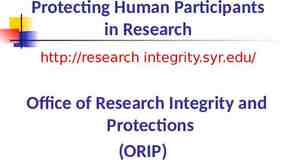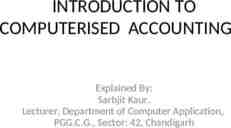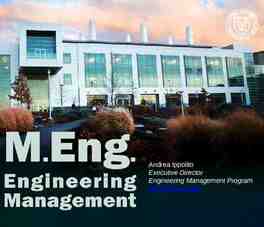Wireless Networks By Waheed ur Rehman wahrehman@gmail
35 Slides1.30 MB

Wireless Networks By Waheed ur Rehman [email protected]

My Introduction Name : Waheed ur Rehman Designation : Assistant Professor Qualification: PhD : Communication and Information Engineering from (Beijing University of Posts and Telecommunication: : 2015) MS Mobile Communication (University of Westminster, UK in 2007) MSc Computer Science (Department of Computer Science, University of Peshawar, 2002 )

Class Introduction

At the End of the Course You Should be able to know What is wireless communication What are the current wireless trends How would the future look like for wireless communication what are the different issues and challenges in future wireless and mobile communication

Course Introduction Wireless and Mobile Communication Recommended Books –Wireless Communication and Networks 2nd Edition by William Stallings –Data Communication and Networks 4th Edition, by Behrouz A. Forouzan –Wireless Communication by Rapaport –Mobile Communication by Jochen Schiller

Course Contents Introduction – Chapter 1,3 (Behrouz) History, Transmission Fundamental like Time domain and Frequency domain, Analog and Digital Signals, Frequency, Phase, Time Period, Periodic and Aperiodic Signals, Noise and its types, free space loss, Attenuation etc. Communication Networks – Chapter 8(Behrouz) LAN, MAN, WAN, Switching Techniques, packet and circuit switching Protocol and TCP/IP suite – Chapter 2 (Behrouz) Wireless Communication Technology Antenna, Propagation Modes, LOS, Ground wave and Sky wave, Multipath propagation. Chapter 6 of William Stalling book, Signal Encoding Techniques , (TEST / Assignment) Multiple Access Techniques (Behrouz) Random Access, Controlled Access and Channelization Techniques

Course Contents Cellular Concepts ( Rapaport ) Frequency reuse, channel assignment strategies (fixed and dynamic), sector, handover and its types, Ho strategies, Cell capacity, increasing cell capacity, micro, macro and femto cells. Cellular networks like 1G, 2G, 3G, 4G, 5G Wireless Networks like 802.11 (wifi), 802.16 (WiMAX), 802.15(Bluetooth), Infrared Post Midterm (discussion, presentation, assignments) Device to device communication, Machine type communication, data offloading and caching, cooperative communication, communication in mmWave band, smart cities and smart societies, internet of things, cloud and fog computing, powerline communication, Current Issues in wireless and mobile networks – A discussion

What You Should Already know OSI Model TCP/IP Model Packet and Circuit Switching Multiplexing Types of Medium and their characteristics Basics of Transmission e.g. models of transmission, types etc. WiFi and Ethernet etc. Delays and its types -----------? Addressing and its types-----------? IP and its versions-------------------?

The great pleasure in life is doing what people say you cannot do

Short History Use of light in ancient times Smoke signals (150 BC) Start of electromagnetic waves in 1830s Marconi (1874-1937) demonstration of wireless telegraphy in 1895 First radio broadcast in 1906 1907, commercial transatlantic connections were setup (huge antennas were used)

Short History 1915 – first wireless voice setup between Washington and San Francisco. 1920 – first commercial radio (still huge antennas and high power) 1920 – Marconi discover short waves (reflection – ionosphere) 1926 – First telephone on train between Berlin-Hamburg 1927 – first commercial car radio

Short History 1927 – TV broadcast starts Up until 1933, amplitude modulation was used – poor quality due to interference 1933 – frequency modulation by E.H. Armstrong 1958 – first wireless network in Germany was analog A-Netz, carrier frequency of 160MHz, – Connection establishment from mobile station only – No handovers 1971 – A-Netz had 80% coverage with 11,000 customers

Short History 1972 – B-Netz using the same frequency 160MHz – Connection establishment from fixed phones as well 1979 – Denmark, Finland, Norway and Sweden agreed on Nordic Mobile Telephone (NMT) – 450 MHz – Latter on NMT 900MHz in 1986

Short History 1982 – pan European Mobile Phone system aiming at – New spectrum at 900MHz – Allow roaming through out europe – Be fully digital – Offer voice and data services Global system for Mobile (GSM) was founded

Short History 1983 – AMPS- Advance Mobile Phone System working at 850MHz (IS-88) 1984 - CT1 – Cordless telephones (followed by its predecessors CT0 -1980) 1985-90 – C-Netz with support of handovers 1991 – fully digital systems

Short History DECT – Digital European Cordless Telephones – 100-500 meters range – 120 duplex channels – 1.2Mbps for data transmission – Support several 10,000 users/km2 – Used in more than 40 countries – Renamed as Digital Enhanced Cordless Telecomm

Short History 1991 – GSM was standardized – 900 MHz – 124 full duplex channels – Full international roaming – 9.6kbps data rate – 13kbps voice rate GSM 1800 In US no standardization results in different systems IN US – AMPS (IS-88) – TDMA (IS-136) – CDMA (IS-95)

Short History GSM at 1800 MHz also called DCS 1800 US uses GSM at 1900 MHz called PCS1900 1996 HIPERLAN – HIgh PErformance Radio Local Area Network 1997 – 802.11 @ 2.4GHz 1998 – beginning of mobile communication using satellite with Iridium System – Consist of 66 satellite in LEO at 1.6GHz

Short History 1998 – European agreed on UMTS Universal Mobile Telecommunication System at 2GHz and 2Mbps 1999 – several powerful WLANs 802.11b at 2.4GHz @11Mbps 802.11a at 5GHz @ 54Mbps 2000 – packet oriented transmission GPRS, HSCSD 2001 – 3G system started in Japan

Short History 2002 – 802.11g at 2.4GHz and 54Mbps and many Bluetooth applications Nov 2002 – Digital TV terrestrial (DVB-T) in Berlin High quality TV on the move and require an antenna of few centimeters

Whats Next? Next Generation Wireless Networks? Next Generation Mobile phones ? Mobile networks are effected by heavy rain .?

Transmission Fundamentals Signal Time Domain Frequency Domain Frequency, Phase, Time Period, Wavelength

Signal Carrier of the data Layer 1 is responsible for data -- signal Do we need more signals on medium or more data ?

Antenna Couples Electromagnetic energy to and from space and from a wire or coaxial cable. Isotropic radiator / antenna – A reference antenna that radiate equally in all directions – Radiation pattern is symmetric in all directions (practically not possible) Real antennas have directive effect Directive antennas are used to over come the environmental challenges

Antenna In mobile comm. Directive antennas are called sectorized antennas Two or more antennas can be combine to improve reception called multi-element antenna array Antennas should be apart 2

Signal Propagation Wired comm have direction of propagation ie follow the medium Not the case in wireless, No uniform medium characteristics for wireless The situation can be – Transmission range – Detection range – Interference range

Path Loss of Radio Signal Signal follow the straight path and get attenuated Attenuate means loss of energy dB 10log10 P2/P1 Inverse square law Pr 1/d2 Atmosphere can degrade signal strength Radio wave exhibits 3 fundamental behavior – Ground waves ( 3MHz) – Sky waves (3-30MHz) – LOS ( 30MHz)

Additional Signal Propagation Effects Blocking or Shadowing – is the effect that the received signal power fluctuates due to objects obstructing the propagation path between transmitter and receiver. – Caused by blocking of the signal – A small wall or a tree Reflection – If an object is larger than the wavelength of the signal – Huge building, mountain – Help NLOS communication

Additional Signal Propagation Effects Refraction – Waves that travel into a denser medium are bend towards the medium – One reason, waves bend towards earth (atmosphere closer to earth is denser) Scattering – Scattering is what happens when a wave impinges (strikes) on an object that is rough or has irregularities with dimensions on the order of the wavelength. – If the size of an object is in the order of the wavelength – GSM, AMPS signals are 10 cm

Additional Signal Propagation Effects Diffraction – Diffraction is the “bending” of waves around sharp corners. – Important examples of diffraction include waves bending over the tops of buildings, around street corners, and through doorways. – Radio waves will be diffracted at an edge and propagate in different directions.

Multipath Propagation More than one reflected or diffracted signal at the receiver arriving at different times Called delay spread This effect has nothing to do with the possible movement of sender or receiver Typical values for delay spread is 3μs in cities, upto 12μs can be observed GSM tolerate upto 16μs i.e.3km path difference

Doppler effect The Doppler effect (or the Doppler shift) is the change in frequency or wavelength of a wave in relation to an observer who is moving relative to the wave source.









